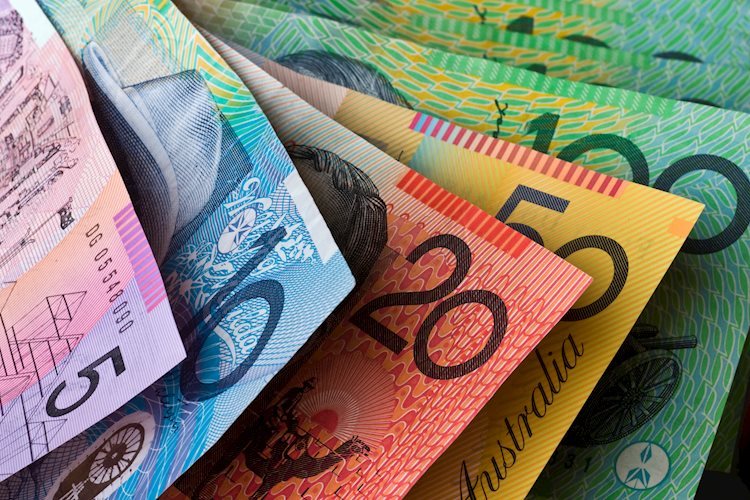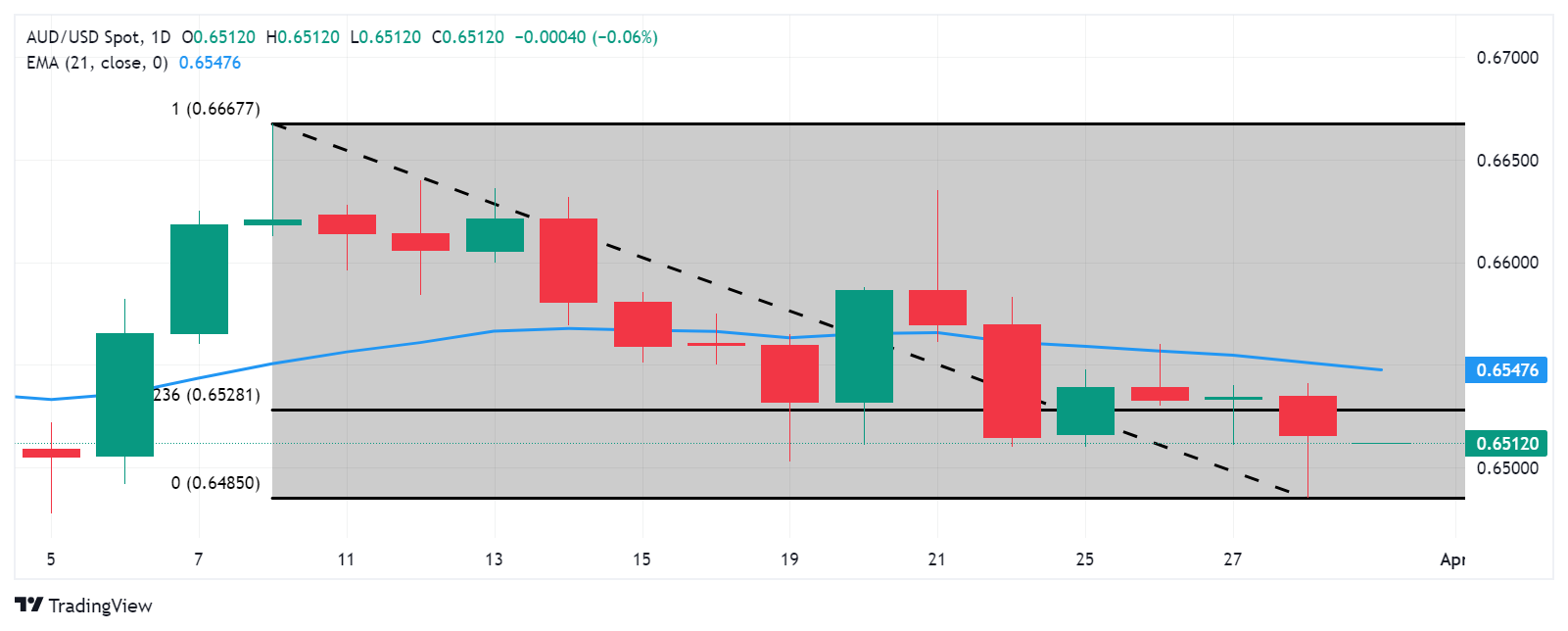Products You May Like
- Australian Dollar remains tepid as market bias leans towards RBA adopting a dovish stance.
- Australia’s central bank may consider cutting interest rates in the second half of 2024.
- US Dollar strengthens as recent data suggests that the Fed may delay implementing rate cuts shortly.
The Australian Dollar (AUD) extends its losses for the second successive session on Friday. However, market activity is expected to be subdued due to light trading on Good Friday. Meanwhile, the US Dollar (USD) strengthens as recent data indicates annualized economic expansion in the United States (US), driven by consumer spending. This development undermines the AUD/USD pair.
The Australian Dollar encountered difficulties amid weaker Consumer Inflation Expectations and Retail Sales figures from Australia. These indicators raised expectations of potential interest rate cuts by the Reserve Bank of Australia (RBA) in the latter half of 2024. Furthermore, Wednesday’s release of the softer Australian Monthly Consumer Price Index further reinforced this outlook.
The US Dollar Index (DXY) seems poised to extend its winning streak, buoyed by hawkish comments from a Federal Reserve (Fed) official that bolstered the Greenback. Fed Governor Christopher Waller’s remarks on Wednesday suggested that the central bank might delay interest rate cuts in light of robust inflation data. Investors now await the US Personal Consumption Expenditures (PCE) report on Friday, which serves as the Fed’s preferred inflation gauge, to gain additional insight and guidance.
Daily Digest Market Movers: Australian Dollar depreciates as RBA may adopt a dovish stance
- Australia’s Consumer Inflation Expectations came in at 4.3% in March, a slight decrease from the previous increase of 4.5%.
- The seasonally adjusted Aussie Retail Sales showed a month-over-month increase of 0.3% in February, falling short of the expected 0.4% and the prior 1.1%.
- Australia’s Monthly Consumer Price Index (YoY) for February saw a 3.4% rise, maintaining consistency with previous levels but slightly below the anticipated 3.5%.
- Australia’s government has pledged to support a minimum wage increase aligned with inflation this year, recognizing the ongoing challenges low-income families face amid rising living costs.
- At the Boao Forum for Asia (BFA), China’s top legislator, Zhao Leji, emphasized China’s stance on inclusive economic globalization. He stated that China opposes unilateralism and protectionism in all their forms and is committed to closely linking its development with other countries.
- Federal Reserve Board Governor Christopher Waller still sees ‘no rush’ to cut rates amid sticky inflation data.
- Atlanta Fed President Raphael Bostic expressed his expectation for just one rate cut this year, cautioning that reducing rates prematurely could lead to greater disruption.
- US Gross Domestic Product Annualized expanded by 3.4% in the fourth quarter of 2023. The market expectation was to be unchanged at a 3.2% increase.
- The US Gross Domestic Product Price Index remained consistent at a 1.7% increase, as expected in Q4.
- Core Personal Consumption Expenditures (QoQ) came in at 2.0% in the fourth quarter, slightly below the expected and previous reading of 2.1%.
- US Initial Jobless Claims fell to 210K in the week ending on March 22, against the expected increase to 215K from 212K prior.
Technical Analysis: Australian Dollar hovers above psychological support at the 0.6500 level
The Australian Dollar trades near 0.6510 on Friday. Immediate resistance is noted around the 23.6% Fibonacci retracement level at 0.6528, followed by the 21-day Exponential Moving Average (EMA) at 0.6547, and the significant barrier of 0.6550. On the downside, a notable support level is located at the psychological mark of 0.6500, followed by March’s low at 0.6477. A breach below this level could potentially lead the AUD/USD pair to test the major support level at 0.6450.
AUD/USD: Daily Chart
Australian Dollar price today
The table below shows the percentage change of Australian Dollar (AUD) against listed major currencies today. Australian Dollar was the weakest against the Japanese Yen.
| USD | EUR | GBP | CAD | AUD | JPY | NZD | CHF | |
| USD | 0.15% | 0.02% | 0.11% | 0.03% | -0.10% | 0.03% | 0.15% | |
| EUR | -0.15% | -0.14% | -0.03% | -0.10% | -0.24% | -0.13% | 0.00% | |
| GBP | -0.01% | 0.13% | 0.11% | 0.03% | -0.09% | 0.01% | 0.15% | |
| CAD | -0.12% | 0.02% | -0.11% | -0.07% | -0.24% | -0.11% | 0.03% | |
| AUD | -0.04% | 0.09% | -0.06% | 0.06% | -0.14% | -0.01% | 0.11% | |
| JPY | 0.11% | 0.25% | 0.12% | 0.22% | 0.19% | 0.14% | 0.27% | |
| NZD | -0.02% | 0.11% | -0.02% | 0.10% | 0.00% | -0.11% | 0.13% | |
| CHF | -0.14% | -0.03% | -0.07% | 0.03% | -0.09% | -0.26% | -0.14% |
The heat map shows percentage changes of major currencies against each other. The base currency is picked from the left column, while the quote currency is picked from the top row. For example, if you pick the Euro from the left column and move along the horizontal line to the Japanese Yen, the percentage change displayed in the box will represent EUR (base)/JPY (quote).
Australian Dollar FAQs
One of the most significant factors for the Australian Dollar (AUD) is the level of interest rates set by the Reserve Bank of Australia (RBA). Because Australia is a resource-rich country another key driver is the price of its biggest export, Iron Ore. The health of the Chinese economy, its largest trading partner, is a factor, as well as inflation in Australia, its growth rate and Trade Balance. Market sentiment – whether investors are taking on more risky assets (risk-on) or seeking safe havens (risk-off) – is also a factor, with risk-on positive for AUD.
The Reserve Bank of Australia (RBA) influences the Australian Dollar (AUD) by setting the level of interest rates that Australian banks can lend to each other. This influences the level of interest rates in the economy as a whole. The main goal of the RBA is to maintain a stable inflation rate of 2-3% by adjusting interest rates up or down. Relatively high interest rates compared to other major central banks support the AUD, and the opposite for relatively low. The RBA can also use quantitative easing and tightening to influence credit conditions, with the former AUD-negative and the latter AUD-positive.
China is Australia’s largest trading partner so the health of the Chinese economy is a major influence on the value of the Australian Dollar (AUD). When the Chinese economy is doing well it purchases more raw materials, goods and services from Australia, lifting demand for the AUD, and pushing up its value. The opposite is the case when the Chinese economy is not growing as fast as expected. Positive or negative surprises in Chinese growth data, therefore, often have a direct impact on the Australian Dollar and its pairs.
Iron Ore is Australia’s largest export, accounting for $118 billion a year according to data from 2021, with China as its primary destination. The price of Iron Ore, therefore, can be a driver of the Australian Dollar. Generally, if the price of Iron Ore rises, AUD also goes up, as aggregate demand for the currency increases. The opposite is the case if the price of Iron Ore falls. Higher Iron Ore prices also tend to result in a greater likelihood of a positive Trade Balance for Australia, which is also positive of the AUD.
The Trade Balance, which is the difference between what a country earns from its exports versus what it pays for its imports, is another factor that can influence the value of the Australian Dollar. If Australia produces highly sought after exports, then its currency will gain in value purely from the surplus demand created from foreign buyers seeking to purchase its exports versus what it spends to purchase imports. Therefore, a positive net Trade Balance strengthens the AUD, with the opposite effect if the Trade Balance is negative.

